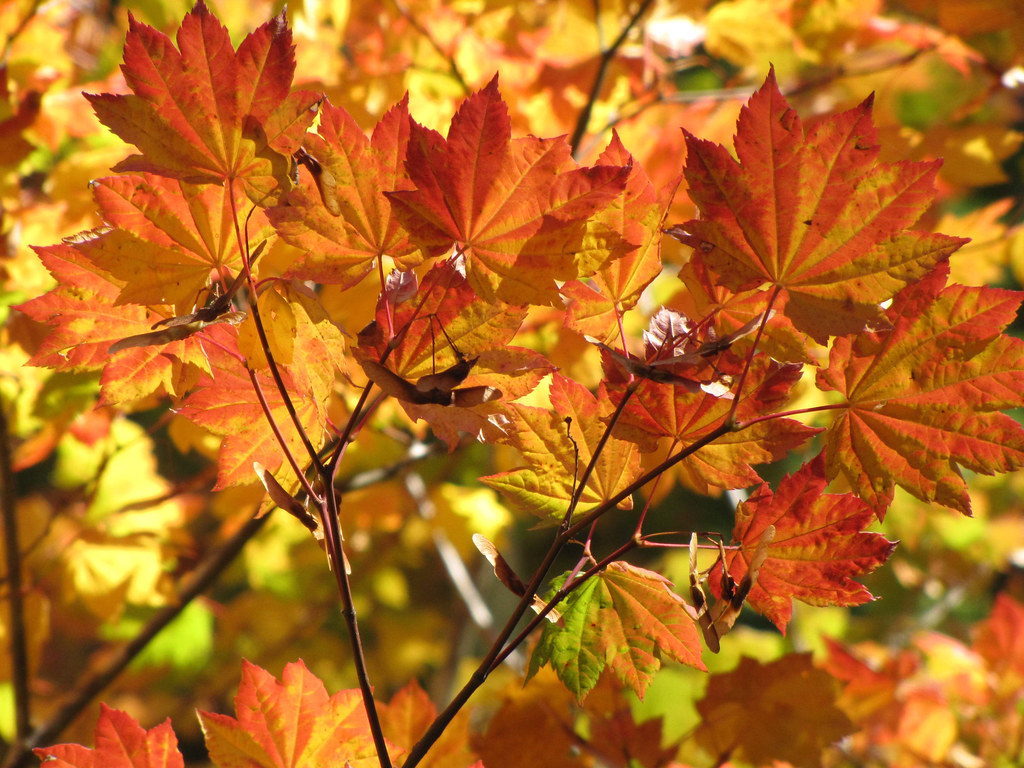Description
Sold as bareroot in bundles of 10. (12+ inches tall)
At a Glance: Tall, erect, multi-trunked shrub or small tree with sprawling branches.
Height: 13-26 feet (4-8 meters)
Stems: Bark is initially smooth and bright green, eventually turning brown with age.
Leaves: Leaves are palmate (arranged like fingers on the palm of a hand) with seven to nine lobes; leaf surfaces are hairy on upper and lower sides and along veins; margins are toothed. Size: 5-12 cm (2-5 in) across. Leaves are green in spring; in early fall they turn orange-red or red in full sun or golden in the shade. Additionally, leaves are oppositely arranged on branches.
Flowers: Flowers grow in small loose clusters at the end of shoots. Flower sepals are purple and red, hairy and spreading; petals are creamy white with purple/red highlights. Flower size: 6-9 mm across.
Flowering Period: May, June.
Fruits: The fruit is a two-seeded winged fruit called a samara. The wings of the samara point away from each other on the same horizontal plane. Size: 2-4 cm (0.8-2 in) long; color: fruits are initially green then later turn a reddish-brown.
General Uses: Vine Maple is used as an ornamental species. The autumn leaf color can be quite vivid, particularly when grown in the sun.
Conservation Uses: Vine Maple is an important conservation species for a variety of reasons. It is adapted to a wide range of sites. It can be used as a pioneering species on open, disturbed sites, or as an understory species growing along pre-existing woodland. It is a common component of riparian zones throughout the region. Once established, its roots are effective soil stabilizers. It has numerous uses in wildlife habitat restoration. Its seeds are an important food source for many species of birds, squirrels, and rodents. Deer and elk browse on its leaves and stems too.
Helpful Tips: As with any newly planted tree, it should be watered during the dry season for the first 2-3 years until it becomes established. Click HERE to determine your recommended planting density.
| Sun/Shade Tolerance | Hydrology | Elevation Range |
| Shade tolerant and commonly found in understories.
full sun > 80%
mostly sunny 60%-80%
partial sun and shade 40%- 60%
mostly shady 60%-80%
full shade > 80%
|
Favors well drained moist to wet soils.
wet
moist
dry
Wetland Indicator Status: |
Found at elevations below 760 meters.
low elevation
mid elevation
sub-alpine
high elevation
|
| Soil Preferences | ||
| Prefers well drained, nitrogen-rich soils. | ||
|
sandy soils
gravelly soils
clay soils
muddy soils
peaty soils
|
well drained soils
shallow soils
deep soils
acidic soils
basic soils
|
humic soils
nutrient rich soils
nutrient poor soils
mineral soils
organic soils
|
| Wildlife Value | |
|
Berries
Seeds
Nectar for hummingbirds
Nectar for butterflies
Host for insect larvae
Thickets and shelter
Thorny or protective cover
|
Birds: Birds that eat the seeds include grosbeaks, woodpeckers, nuthatches, finches, quail, and grouse. Insects: A larvae plant for the brown tissue moth and the Polyphemus moth. A good nectar source for bees. Mammals: Deer, mountain beavers, and other beavers eat the twigs and wood. |
| Ethnobotanical Uses and Other Facts |
| Material Uses: Vine maple wood is very dense and hard. It was used by northwest native groups to build snowshoe frames, drum hoops, and a variety of other small implements such as spoons and dishes. The Quinault peoples used the hard wood to make baskets. The Quinault, Chehalis, Quileute, and Lummi used the wood to construct dipnet fish traps. The Quinault also used the wood to hold down the roof planks on houses. The Skagit used the wood to make babies cradles and salmon tongs. Many groups used the wood for fire fuel. The Quinault used the burnt charcoal and mixed it with oil to make black paint. The Suquamish and Cowichan used the wood to make knitting needles. The Suquamish and Katzie also sometimes used the wood to make bows from the straighter branches. |
References:
Pojar, Jim, and Andy MacKinnon. Plants of the Pacific Northwest Coast: Washington, Oregon, British Columbia & Alaska. Revised ed. Redmond, Wash.: B.C. Ministry of Forests and Lone Pine Pub., 2004. Print.
“Sound Native Plants.” Sound Native Plants. Web. 31 Oct. 2014. <www.soundnativeplants.com>.





